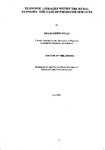ECONOMIC LINKAGES WITHIN THE RURAL ECONOMY: THE CASE OF PRODUCER SERVICES
| dc.contributor.author | MILLS, BRYAN KEITH | |
| dc.contributor.other | Faculty of Science and Engineering | en_US |
| dc.date.accessioned | 2014-01-24T15:05:27Z | |
| dc.date.available | 2014-01-24T15:05:27Z | |
| dc.date.issued | 2002 | |
| dc.identifier | Not available | en_US |
| dc.identifier.uri | http://hdl.handle.net/10026.1/2868 | |
| dc.description | Merged with duplicate record: 10026.1/1615 on 01.02.2017 by CS (TIS) | |
| dc.description.abstract |
This research seeks to contribute towards the understanding of economic linkage within the rural context by exploring the relationship between rurally located small to medium-sized enterprises (SMEs) and their purchase of producer (business) services. In addition, the work considers other inter-rural and intra-rural differences, in both firm (SME) behaviour and firm characteristics. Whilst the subject of linkages has been explored by other researchers, the market town and SME focus of this thesis provides a more spatially contained framework than is often encountered within this type of research. By using four towns of similar size and structure contained within two noticeably different counties, the work is able to explore difference within the rural setting. Given its emphasis on market towns, rural areas, SMEs, the service sector and indigenous growth potential, the work contributes to current debates in both academia and in national and European government policy. The underlying hypothesis is that integration, in terms of local spending on producer services, is a function of a firm's characteristics. In order to test this hypothesis, data was collected from four rural towns, and a logistic regression model was constructed using variables that described both firms' characteristics and proportion of spend on services in their resident town. The model was then tested using data collected firom a further two towns. This thesis shows that there is a relationship between a firm's characteristics and the location of the firm's producer service spending, enhancing our understanding of firms operating within the rural context. Key characteristic variables that are shown to have a relationship with producer service spend location are: firm Standard Industrial Classification (SIC), size (in terms of total sales, total number of hours worked by all staff), total spend on producer services by firm and distance that the current location is from the firm's previous location. Given the changing role and nature of rural firms, this research provides timely information concerning the relationship between firms and service providers. | en_US |
| dc.language.iso | en | en_US |
| dc.publisher | University of Plymouth | en_US |
| dc.subject | Producer Services | en_US |
| dc.subject | Economic Linkages | en_US |
| dc.subject | Rural SMEs | en_US |
| dc.subject | Decision-making | en_US |
| dc.subject | Indigeneity | en_US |
| dc.subject | Virtual Employees | en_US |
| dc.subject | Quasi-Products | en_US |
| dc.subject | Market Towns | en_US |
| dc.subject | Indigenous Growth | en_US |
| dc.title | ECONOMIC LINKAGES WITHIN THE RURAL ECONOMY: THE CASE OF PRODUCER SERVICES | en_US |
| dc.type | Thesis | |
| plymouth.version | Full version | en_US |
| dc.identifier.doi | http://dx.doi.org/10.24382/3981 |
Files in this item
This item appears in the following Collection(s)
-
01 Research Theses Main Collection
Research Theses Main


